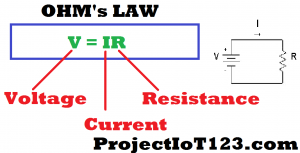What is a Resistor Leave a comment
 Hello friends I hope you all are fine; I am starting a new series of articles in which I will discuss the introduction of all the discrete electronic components. In this article I will discuss the resistors which is one of the most commonly used electronic components.
Hello friends I hope you all are fine; I am starting a new series of articles in which I will discuss the introduction of all the discrete electronic components. In this article I will discuss the resistors which is one of the most commonly used electronic components.
What is a Resistor
After reading this post the reader will be able to learn the resistor, applications of the resistors, different packages of the resistors and finally the OHM’s LAW. So sit back, keep reading and enjoy learning.
Resistor( Resistance):
The resistor is an electronic component that is employed in almost every discrete or integrated circuit. It is a two terminal element and is passive which means that during the normal operation the resistor consumes or dissipates the power. The primary purpose of the resistor is to the limit the current and thus also provides the voltage drop across itself. It is important to note that the resistor realizes an important electrical characteristic. The three primary electrical characteristics are:
1) Resistance.
2) Capacitance.
3) Inductance.
By resistance it means the opposition to the flow of electrons and thus resistor implements the resistance in the electronic circuit.
Ohm (Unit of Resistance):
There is a unit to measure any physical quantity for example the mass of an object is measured in grams and the length of an object is measured in meter. In a similar way the unit to measure the opposition of the flow of the current of a conductor is Ohm.
Definition of Ohm:
A conductor is said to have a resistance of 1 ohm if one ampere current flows through it when the potential difference of 1 volt is applied across its two ends. The symbol of ohm is as shown in the following image:
OHM’s Law:
The relationship between the voltage, current and resistance is given by the Ohm’s Law whose formula is given in the following image. As shown in the image below that the voltage across the resistor is equal to the product of current through it and resistance. In other words the current through the resistor is directly proportional to the voltage applied across its ends where resistance is the constant of proportionality.
Resistor Packages:
Resistors are available in two types of packages one is
- Through hole and the other is
- SMT that is surface mounted.
Types of Resistor Packages:
Although the electrical characteristics of the two types of resistor packages are same the difference is in its assembly and printed circuit board footprint. The SMT and Through Hole resistor packages are as shown in the following image:
Applications of Resistors:
The common applications of resistors are listed as follows;
- Resistors are used for biasing the Integrated Circuit.
- Resistors are used as Pull Up and Pull Down Resistors.
- Resistors are used in op amp feedback network.
- Resistors are used adjusting the signal level.
- Resistors are used in dividing the voltages.
- Resistors are also used for limiting the current.
- Resistors are employed for terminating the transmission lines.
- Resistors are also used for adjusting the input and output impedance of the circuit.
That is all for now, I hope this article would be useful for you. In the next article I will come up with more interesting topics in engineering. Till then stay connected, keep reading and enjoy learning.



